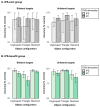Right Parietal rTMS Induces Bidirectional Effects of Selective Attention upon Object Integration
- PMID: 40426654
- PMCID: PMC12110648
- DOI: 10.3390/brainsci15050483
Right Parietal rTMS Induces Bidirectional Effects of Selective Attention upon Object Integration
Abstract
Background/Objectives: Part-to-whole object completion and search guidance by salient, integrated objects has been proposed to require attentional resources, as shown by studies of neglect patients suffering from right-parietal brain damage. The current study was performed to provide further causal evidence for the link between attention and object integration. Methods: Healthy observers detected targets in the left and/or right hemifields, and these targets were in turn embedded in various Kanizsa-type configurations that systematically varied in the extent to which individual items could be integrated into a complete, whole object. Moreover, repetitive transcranial magnetic stimulation (rTMS) was applied over the right intraparietal sulcus (IPS) and compared to both active and passive baseline conditions. Results: The results showed that target detection was substantially facilitated when the to-be detected item(s) were fully embedded in a salient, grouped Kanizsa figure, either a unilateral triangle or a bilateral diamond. However, object groupings in one hemifield did not facilitate target detection to the same extent when there were bilateral targets, one inside the (triangle) grouping and the other outside of the grouped object. These results extend previous findings from neglect patients. Moreover, a subgroup of observers was found to be particularly sensitive to IPS stimulation, revealing neglect-like extinction behavior with the single-hemifield triangle groupings and bilateral targets. Conversely, a second subgroup showed the opposite effect, namely an overall, IPS-dependent improvement in performance. Conclusions: These explorative analyses show that the parietal cortex, in particular IPS, seems to modulate the processing of object groupings by up- and downregulating the deployment of attention to spatial regions were to-be-grouped items necessitate attentional resources for object completion.
Keywords: intraparietal sulcus; object integration; parietal cortex; perceptual grouping; rTMS; visual attention; visual extinction.
Conflict of interest statement
The authors declare no conflicts of interest.
Figures




Similar articles
-
Attention capture by salient object groupings in the neglected visual field.Cortex. 2021 May;138:228-240. doi: 10.1016/j.cortex.2021.02.011. Epub 2021 Feb 24. Cortex. 2021. PMID: 33730606
-
Object integration requires attention: Visual search for Kanizsa figures in parietal extinction.Neuropsychologia. 2016 Nov;92:42-50. doi: 10.1016/j.neuropsychologia.2016.06.006. Epub 2016 Jun 8. Neuropsychologia. 2016. PMID: 27288114
-
Attentional responses to unattended stimuli in human parietal cortex.Brain. 2005 Dec;128(Pt 12):2843-57. doi: 10.1093/brain/awh522. Epub 2005 Apr 27. Brain. 2005. PMID: 15857928
-
The contribution of spatial remapping impairments to unilateral visual neglect.Neurosci Biobehav Rev. 2004 Apr;28(2):181-200. doi: 10.1016/j.neubiorev.2004.03.003. Neurosci Biobehav Rev. 2004. PMID: 15172763 Review.
-
The Ties that Bind: Agnosia, Neglect and Selective Attention to Visual Scale.Curr Neurol Neurosci Rep. 2021 Sep 29;21(10):54. doi: 10.1007/s11910-021-01139-6. Curr Neurol Neurosci Rep. 2021. PMID: 34586544 Review.
References
-
- Driver J., Baylis G. The Attentive Brain. The MIT Press; Cambridge, MA, USA: 1998. Attention and visual object segmentation; pp. 299–325.
-
- Karnath H.O., Milner A.D., Vallar G. The Cognitive and Neural Bases of Spatial Neglect. Oxford University Press; Oxford, UK: New York, NY, USA: 2002.
Grants and funding
LinkOut - more resources
Full Text Sources

